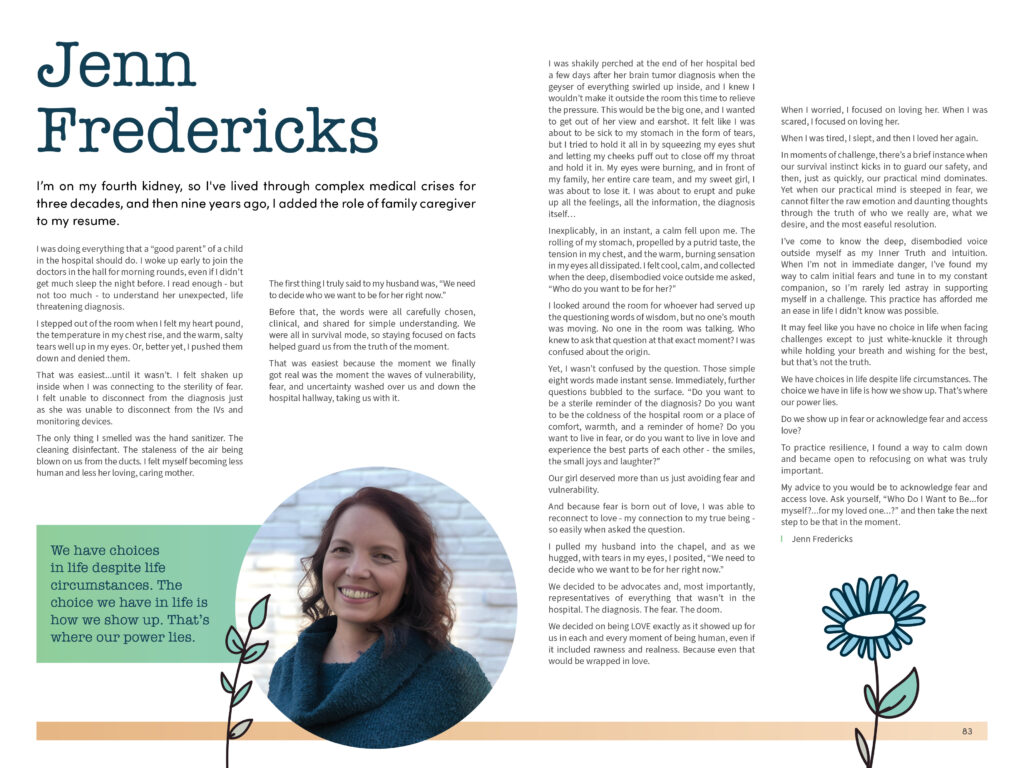I’m on my fourth kidney, so I’ve lived through complex medical crises for three decades, and then nine years ago, I added the role of family caregiver to my resume.
I was doing everything that a “good parent” of a child in the hospital should do. I woke up early to join the doctors in the hall for morning rounds, even if I didn’t get much sleep the night before. I read enough – but not too much – to understand her unexpected, life threatening diagnosis.
I stepped out of the room when I felt my heart pound, the temperature in my chest rise, and the warm, salty tears well up in my eyes. Or, better yet, I pushed them down and denied them.
That was easiest…until it wasn’t. I felt shaken up inside when I was connecting to the sterility of fear. I felt unable to disconnect from the diagnosis just as she was unable to disconnect from the IVs and monitoring devices.
The only thing I smelled was the hand sanitizer. The cleaning disinfectant. The staleness of the air being blown on us from the ducts. I felt myself becoming less human and less her loving, caring mother.
The first thing I truly said to my husband was, “We need to decide who we want to be for her right now.”
Before that, the words were all carefully chosen, clinical, and shared for simple understanding. We were all in survival mode, so staying focused on facts helped guard us from the truth of the moment.
That was easiest because the moment we finally got real was the moment the waves of vulnerability, fear, and uncertainty washed over us and down the hospital hallway, taking us with it.
I was shakily perched at the end of her hospital bed a few days after her brain tumor diagnosis when the geyser of everything swirled up inside, and I knew I wouldn’t make it outside the room this time to relieve the pressure. This would be the big one, and I wanted to get out of her view and earshot. It felt like I was about to be sick to my stomach in the form of tears, but I tried to hold it all in by squeezing my eyes shut and letting my cheeks puff out to close off my throat and hold it in. My eyes were burning, and in front of my family, her entire care team, and my sweet girl, I was about to lose it. I was about to erupt and puke up all the feelings, all the information, the diagnosis itself…
Inexplicably, in an instant, a calm fell upon me. The rolling of my stomach, propelled by a putrid taste, the tension in my chest, and the warm, burning sensation in my eyes all dissipated. I felt cool, calm, and collected when the deep, disembodied voice outside me asked, “Who do you want to be for her?”
I looked around the room for whoever had served up the questioning words of wisdom, but no one’s mouth was moving. No one in the room was talking. Who knew to ask that question at that exact moment? I was confused about the origin.
Yet, I wasn’t confused by the question. Those simple eight words made instant sense. Immediately, further questions bubbled to the surface. “Do you want to be a sterile reminder of the diagnosis? Do you want to be the coldness of the hospital room or a place of comfort, warmth, and a reminder of home? Do you want to live in fear, or do you want to live in love and experience the best parts of each other – the smiles, the small joys and laughter?” Our girl deserved more than us just avoiding fear and vulnerability.
And because fear is born out of love, I was able to reconnect to love – my connection to my true being – so easily when asked the question.
I pulled my husband into the chapel, and as we hugged, with tears in my eyes, I posited, “We need to decide who we want to be for her right now.”
We decided to be advocates and, most importantly, representatives of everything that wasn’t in the hospital. The diagnosis. The fear. The doom.
We decided on being LOVE exactly as it showed up for us in each and every moment of being human, even if it included rawness and realness. Because even that would be wrapped in love.
When I worried, I focused on loving her. When I was scared, I focused on loving her.
When I was tired, I slept, and then I loved her again.
In moments of challenge, there’s a brief instance when our survival instinct kicks in to guard our safety, and then, just as quickly, our practical mind dominates. Yet when our practical mind is steeped in fear, we cannot filter the raw emotion and daunting thoughts through the truth of who we really are, what we desire, and the most easeful resolution.
I’ve come to know the deep, disembodied voice outside myself as my Inner Truth and intuition. When I’m not in immediate danger, I’ve found my way to calm initial fears and tune in to my constant companion, so I’m rarely led astray in supporting myself in a challenge. This practice has afforded me an ease in life I didn’t know was possible.
It may feel like you have no choice in life when facing challenges except to just white-knuckle it through while holding your breath and wishing for the best, but that’s not the truth.
We have choices in life despite life circumstances. The choice we have in life is how we show up. That’s where our power lies.
Do we show up in fear or acknowledge fear and access love?
To practice resilience, I found a way to calm down and became open to refocusing on what was truly important.
My advice to you would be to acknowledge fear and access love. Ask yourself, “Who Do I Want to Be…for myself?…for my loved one…?” and then take the next step to be that in the moment.

Are you ready to share your story of RESILIENCE? You can do that HERE.
